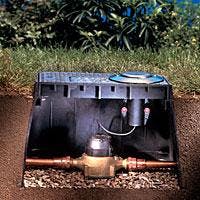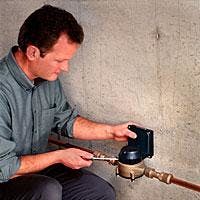AMR Business Case Check-up: Technology's Value Extends Further Than You Might Think
By Dan Benelisha
Water utilities and municipalities are up against a host of challenges these days, including rising operational costs, a shrinking water supply, a more demanding set of customers, increased competition, and an aging infrastructure. It's a tough new world out there.
Fortunately, Automatic Meter Reading (AMR) technology is up to the task, bringing operational improvements that make life a little easier for water suppliers the world over.
At a basic level, AMR technology enables accurate and timely meter reading, and with unprecedented efficiency. This is accomplished via the installation of a radio-based meter module called an ERT module on a new or existing water meter. Readings are then collected by a meter reader using a handheld or vehicle-based radio device, or by a fixed network system. A meter reader using a handheld computer and walking a route can typically read up to 300 meters during an eight-hour shift. In contrast, a single meter reader equipped with a vehicle-based mobile computer can read up to 15,000 meters reliably and accurately during an eight-hour shift. Such huge efficiency gains lead to immediate and lasting cost savings.
Obtaining readings without setting foot on a customer's property greatly increases safety. Climbing over fences, slipping on ice and snow, and confronting potentially dangerous dogs are just a few of the hazards of meter reading. The process of manually reading a pit-set water meter is not the safest endeavor, either, as meter pits have been know to contain spiders, snakes, and other creatures. The costs of dealing with such inherent dangers, from liability insurance to disability benefits to replacement workers, can be enormous.
Customers receive an added measure of safety as well. An AMR system means meter readers no longer need to enter customers' homes, which means criminals have one less means of deception.
Older, slow-running meters represent a revenue drain for water utilities. Utilities often find that, because of slow-running meters, they are collecting less money than they should be for water used by residents. AMR installation offers the perfect opportunity to fix the problem. With both AMR technology and new meters installed, a water utility and its customers can proceed with confidence that their meter reads and billing are accurate.
Reducing the number of estimated reads is another immediate benefit of automation. The downside of estimated reads is two-fold. Customers hate getting bills based solely on an educated guess, and the utility, in many cases, under-bills. Additionally, the cost of estimated meter reads ripples throughout the utility's revenue cycle. Bills based upon estimated reads create unhappy customers who call to complain, thus increasing call center traffic and associated costs. One of the main reasons cited by utilities of all sizes for switching to an AMR system is the ability to shorten the read cycle and, by extension, the billing cycle. It's a positive step for all sides. Customers who receive an accurate bill on a regular, frequent schedule are more likely to pay quickly and without complaint.
Water is a finite resource, and utilities and municipalities can't keep watching their business literally going down the drain. Western states have a firsthand look at the problem. As droughts persist and population growth continues, the supply of clean drinking water grows shorter, so allowing water leaks and irresponsible usage to go unchecked is simply careless. But these factors cannot be addressed when there is no information to go on. An AMR system enables a utility to stay apprised of where water is actually going, and where it is lost. When data shows that a certain area, or even an individual customer, appears to be using too much, the utility can send a crew to either fix a costly leak or take steps to lessen excessive usage, either by education, conservation incentives, or regulation.
Another trend is the consolidation and privatization of the water industry. With large investor-owned water utilities taking an increasing stake in the industry, a utility or municipality looking to maintain its competitive viability and independence must focus on making its operation as strong as possible. That means improving operational efficiency, serving customers better than before, and decreasing costs, challenges AMR technology meets head on. Conversely, if a municipality wants its water services to become privatized in order to free up public resources for other uses, it would do well to implement a system that makes it more attractive to potential suitors.
Water AMR technology allows for a tremendous degree of flexibility in implementation, deployment, and utilization. An AMR system can be put in place on a gradual schedule of varying speed and technology rollout. A good AMR system should fit any stage of a utility's development and adjust to changing metering needs. And utilities often find that the cost savings associated with an AMR system are so immediate that the implementation practically pays for itself. Today, a wide variety of flexible financing systems put AMR technology well within any utility or municipality's reach.
AMR technology continues to evolve. The most recent step forward is Itron's introduction of a dual-mode ERT module for harsh, pit-set environments. A regular ERT module operates in "wake-up" mode, awaiting a radio signal from a reading device, after which it transmits metering data to a collection system. In addition to wake-up mode, the new dual-mode ERT module can operate in "bubble-up" mode, in which no wake-up signal is required. Instead, the ERT sends a continuous stream of data that can be picked up by most collection systems. When operated in bubble-up mode, no FCC license is required, due to the one-way communication process in an unlicensed radio frequency band.
Water meter compatibility is simply not an issue anymore, an important development since many utilities use different brands of meters scattered throughout their customer base. A high quality AMR system includes endpoint devices or meter modules that fit all major meter types. Likewise, the durability and staying power of AMR systems, always a strength, continues to improve. Battery life now equals the life expectancy of most meters, meaning batteries can be conveniently replaced during normal meter changeouts. And unlike many new technologies that promise a revolution and deliver far less, AMR technology has already been proven effective in some of the largest cities in the country, and some of the smallest municipalities as well.
The nation's water infrastructure is showing its age. An AMR system can be a vital component of a progressive water system overhaul. Rather than spend millions upon millions of dollars to achieve a solution offering bare minimum functionality, utilities and government entities should see impending infrastructure revitalization as an opportunity to put hardware and information together in a comprehensive way.
Water utilities and municipalities indeed have a lot to handle. AMR technology can ease the burden, while creating a foundation for the successful future of any water operation.
About the Author
Dan Benelisha is a marketing communications specialist for Itron Inc. in Spokane, Washington.


